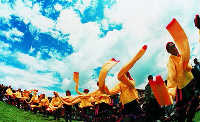| |
Guoxie Dance
( 2005-10-17 )

Guoxie is a group dance popular in the rural areas of Southwest China's Tibet Autonomous Region. The participants dance hand in hand and sing in rotating circles. The dance is often seen in villages, on open squares, and on threshing grounds. At festivals, people dance and sing from sunset tosunrise, marking the rhythm by stamping their feet.
Guoxie is performed to a 2/4 beat with the stress on the first beat. The steps are steady and vigorous, characterized by a marked tempo and a strong sense of people's labor and life. The underlying characteristic of the dance is the expression of collective enthusiasm and joy. This dance is found everywhere in Tibet, but the most renowned version is found in the Shannan area.
The form is largely as follows: At festivals men and women stand hand in hand in two lines around a big vat of highland-barley wine placed on open ground. The two groups first sing and walk from left to right in a circle. When they finish singing, the Xieben (the dance's organizer) leads in shouting, "Xiu, xiu, xiu," and starts the dance with rhythmic steps. This rhythmic shouting is called Xiege (beginning of the song) in Tibetan, which is followed closely by quick-tempo singing and dancing. The two lines of men and women compete in their dancing. After repeated dancing the Xieben leads in shouting, "Xiu, xiu, xiu," or sings alone while the others dance to his tempo. This part of the dance is called the Xiexiu, or finale.
Xiege thus is both the beginning of the song and the initial dance steps to shouts of "Xiu, xiu, xiu," or "Qu, qu, qu." The dancers' shouts are very similar to "One, two, three -- everybody dance!"
As many people participate in Guoxie and it usually does not have any instrumental accompaniment, it is hard to attain uniform dance movements. Xiege is designed to arouse people's enthusiasm and get them moving together. The Xiexiu is usually the climax of the dance, while Xiege sparks the participants' enthusiasm in their concluding climatic dance steps.
|
|

